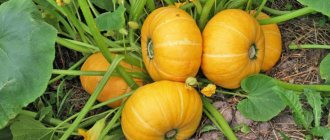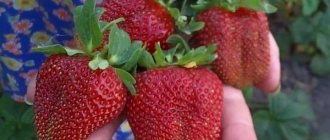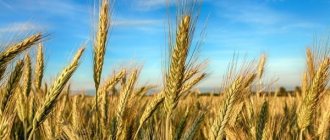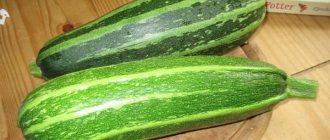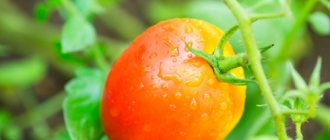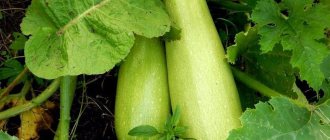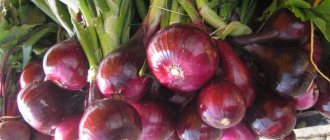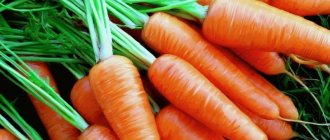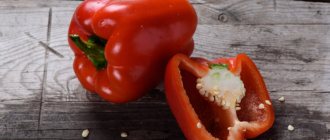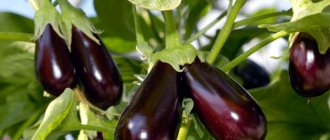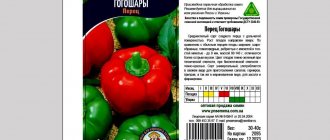Vegetable growing » Pumpkin
3
695
Article rating
Kira Stoletova
There are many legends about this vegetable. The first mention of pumpkin is found in the Bible. These days it is ubiquitous. Both table and fodder pumpkins are unpretentious in cultivation and produce consistently high yields. Both varieties have beneficial properties. The latter is often used as livestock feed, as reflected in its name.
Features of fodder pumpkin
Feeding livestock
Due to its high carbohydrate content, pumpkin is used by livestock farmers as winter feed for cows, pigs and sheep. To do this, it is simply cut in half and fed to animals. Cattle happily eat chopped vegetables even when frozen. In heavily chopped form, it is introduced into the winter menu for chickens.
For 2 months, pumpkin is stored fresh in a dry, dark room at a temperature not exceeding 5 °C. To increase the period of its use, silage feed is made from it, along with leaves, legume grass, and waste from grain production. After that, the fodder beets are placed in silo pits.
Efficiency of pumpkin
After introducing feed pumpkin into the diet of farm animals, the following changes are observed:
- dairy products have a pleasant smell, color and contain more carotene than milk from livestock raised on other feed;
- animals have healthy offspring without complications during childbirth;
- the rate of pig weight gain increases significantly;
- the cow's milk supply increases;
- chickens lay eggs more often, and the yolks of the eggs are rich in color.
The introduction of this vegetable into the diet of animals, due to the peculiarities of its chemical composition, improves their absorption of concentrated roughage feed. As a result, fattening occurs more efficiently, which reduces the farmer’s costs.
The territory of central Russia and the Moscow region
variety Healing Medicinal)
All types of pumpkins are grown in this region of Russia. However, here too there are favorites, which are valued both for their strong immunity and high yield.
Varieties
The “Tselebnaya” variety is early ripening and winter-hardy. With juicy pulp and pleasant flavors. Therefore, it is often used to prepare pumpkin puree or juice.
It is grown both in seedlings and without seedlings. To obtain seedlings, seeds are sown in April; at temperatures above +20 °C, seedlings appear within one week. And in May it is planted in open ground. Gardeners recommend hardening off the seedlings a little first; for this, the seedlings are left in the fresh air during the day and brought indoors at night. When grown without seedlings, the seeds are planted in the ground only in late spring or early summer, when the ground has already warmed up, and frosts can be expected forget.
In order to get an early harvest of this variety, it is necessary to fulfill several requirements of this plant. First, you need a piece of land that is exposed to the sun for the longest time. Secondly, you should not plant other vegetables too close to the pumpkin, because it really loves free space. Thirdly, the plant never minds additional fertilizers. Having fulfilled all these requirements, you will be able to harvest an early harvest that can be preserved for up to six months.
variety Gribovskaya Kustovaya
The Gribovskaya variety is loved for its ability to be used in children's and dietary nutrition. The variety has amazing shelf life for up to 1 year, right up to fresh harvest.
Large pumpkins, from five to over a kilogram, grow on elongated vines. The fruits are round, milky in color and have standard orange flesh. The peel is thin, but it tolerates transportation well, even over long distances. Experienced gardeners write that the quality of taste after several months of storage remains the same, and even improves - it becomes sweeter and more aromatic.
“Gribovskaya Kustovaya-189” - the seeds of this pumpkin are planted directly into the ground. According to the recommendations of breeders, it is advisable to do this in late spring. The fruits are oval-elongated, similar to a large egg, only yellow or slightly orange in color. As the ripening process begins, a green pattern appears on the skin. The pulp is sweet and aromatic, of a standard yellow-orange color.
variety Dachnaya
The “Dachnaya” variety is early ripening, with oval fruits that ripen after 65-75 days. It is valued for its high yield and frost resistance. The plants themselves are not demanding, but will appreciate constant loosening of the soil and a large amount of water. The fruits are sweet, light in weight, on average three kilograms. As soon as the ground warms up to +12-14°C, the seeds can be immediately planted in open ground. No preliminary preparation.
The best varieties
Scientists call this crop a false berry. But these “berries” are among the largest on earth. The fodder crop is characterized by high yield. Its features are its large size, thick peel and loose texture of the pulp.
Sowing seeds per 1 hectare yields up to 50 tons of fruits. This relatively cold-resistant plant has the longest shelf life among other varieties of this vegetable.
Of the large number of species, it is worth highlighting the Stofuntovaya variety. This pumpkin was named so because its mass reaches 25 kg, and sometimes weighs more. The shape of the fruit is spherical. The pulp is orange, the structure is loose. Pumpkin is resistant to transportation and storage.
The variety Volzhskaya gray 92 is widely known. It is noted for its resistance to drought and diseases. It is most widespread in the Volga region due to the presence of sandy soils. Like the previous variety, it stands out for its high yield and large weight.
Varieties such as Hybrid 72, Record, Titan, Gribovskaya Kustovaya 189, etc. are widely used in agriculture.
Decorative pumpkins
This is where the widest range of pumpkin shapes and colors is found. Thanks to these qualities, they are extremely popular in gardening. Every gardener will be able to find something to their liking among all this diversity. They are rarely ever used for anything other than decoration or decoration. They are planted along outbuildings or other structures located on the garden plot, such as gazebos or swings, and also as a hedge along the fence, where bright, variedly shaped small pumpkins attract attention, both in summer and winter.
Varieties
The Orange variety has small fruits, up to 300 g, and in appearance they are very similar to oranges due to their round shape and orange color.
variety "Orange"
The “Kroshka Boo” variety has rounded fruits with ridges on the skin, white with splashes or a milky hue.
“Sweet Dumpling” has small fruits, up to 0.5 kg, and an interesting heterogeneous peel color. The main color is yellow, which is complemented by white dots and green stripes.
"Klein Bicolor" has fruits that look like a pear, with a characteristic horizontal division into two colors - yellow and green. Therefore, the variety is popular not only among gardeners, but also among florists.
variety "Dumpling"
“Chalmovidnaya” is the most interesting variety of decorative pumpkins. It is interesting for its diversity not only of shapes and colors, but also of subspecies, which are almost impossible to classify due to the fact that new ones appear every year. Usually they try to classify this variety by the shape of the pumpkin fruit. Of the most common, gardeners distinguish forms similar to tangerine, pear or star.
Decorative varieties do not require special care. In order for pumpkins to delight with their presence on cold autumn days, it is advisable to plant seedlings in open ground in the first days of summer. If the summer period is short, then it is advisable to plant pumpkin seedlings. Decorative pumpkins love frequent loosening of the soil and plenty of water. This type of plant often has a bushy form, but there are also plants with rather long shoots. Such plants are used to decorate or camouflage garden houses and buildings - sheds, swings, fences, etc. Quite frequent branches are significant in weight and require additional support.
Turban gourd
Now let's try to sort the numerous pumpkin varieties according to territorial principle.
Edibility
Some varieties of fodder pumpkins are eaten
Special cultivated varieties are most widespread in cooking. Pumpkin, due to its unique taste, is not so popular among people. However, some of its varieties, for example Volzhskaya gray 92, are acceptable for consumption.
For many years, this vegetable was eaten only by peasants. The townspeople and those who considered themselves wealthy did not eat it.
On the American continent, this product was eaten by people who were considered the most backward - the Indians. However, as a result of food problems, they began to treat it differently.
And today, pumpkin is one of America's favorite foods. No Thanksgiving is complete without it. Entire fields are sown with this vegetable just for use at Halloween.
Not only the pulp is the edible part of the fruit. Almost all parts of the vegetable have nutritional value: flowers, leaves, seeds, stems. All parts of the plant contain vitamins A, C, as well as iron and calcium. They are boiled, fried, baked. Flowers can even be consumed raw.
Particular preference is given to seeds. They are eaten raw, dried and fried. The pulp contains many nutrients, setting records among many vegetables. There is 5 times more carotene in pumpkin, which is responsible for clarity of vision, than in carrots.
By adding vitamin E to it (oil, dried apricots, seeds), we get a tasty cure for cancer that will improve the quality of the skin, balance hormonal levels and reduce the symptoms of menopause. Due to its low calorie content, obese people include it in their diet.
The vegetable has many advantages, but there are also disadvantages. This variety is contraindicated for those who have an active stage of diseases of the gastrointestinal tract, pancreas, and liver.
If you have an upset stomach, you should also not eat this vegetable. People with severe diabetes are not allowed to eat pumpkin raw.
Decorative balls in the garden
Decorative varieties are very popular among gardeners and gardeners due to the variety of shapes and colors. Small melons, mushrooms and bubbly pears look beautiful on gazebos and along fences.
The most beautiful and unusual
Orange
A pumpkin variety well known to all gardeners. Its fruits weigh no more than 300g and resemble bright orange oranges.
Baby Boo
Baby Boo
The fruits are no less attractive - round, slightly ribbed balls have a milky-white skin color and look impressive in compositions and as decoration on arches.
Sweet Dumpling
Sweet dumpling
Mini pumpkins weigh up to 500 g and have a pale yellow skin color. The yellow color is complemented by green stripes and white dots. The variety is intended for creating decorative compositions.
Kleine Bicolor
kleine-bicolor
The Kleine Bicolor pumpkin variety is distinguished by pear-shaped fruits, divided in half by a clear contour line. Two contrasting colors, yellow and green, give a special decorative charm, making it a favorite of florists.
turban-shaped
In Latin, Cucurbita maxima var.turbaniformis - is represented by various forms that differ from each other in color and size. Based on their shape, they can be divided into several varieties:
- star (crown gourd);
- warty;
- pear-shaped;
- tangerine
Turban gourd
The variety of types and forms of this pumpkin variety is very large and it is impossible to classify them all. Gardeners and gardeners can only replenish their collection with new varieties every year.
Agricultural technology for decorative varieties is no different from caring for musk species. Plants are planted in a permanent place at the end of May. If the summer is short, then it is better to do it in seedlings. Ornamental plants require loose soil and frequent watering.
Representatives of this species most often come in a bush form, but are also found with long vines. They are used to camouflage outbuildings, decorate fences, and gazebos. The plants' vines are heavy and they need strong support to be used in decoration.
Types, varieties and varieties of pumpkin
There are so many pumpkins in nature! And round, and flat, and elongated, in the shape of a jug or like a snake, bright orange, pale yellow, gray with specks, or even green with stripes. The types and varieties of pumpkin are amazing in their diversity. The more difficult it is for a gardener to make a choice.
There are three varieties of pumpkins found in fields, farms, and gardens around the world: hard-boiled, butternut squash, and butternut squash. Among them there are pumpkins with large fruits and portioned ones, bush and climbing pumpkins, with a large number of seeds or very sweet pulp, fodder pumpkins (used to feed animals), table pumpkins (that’s what we eat) or decorative ones. Are you ready to take a closer look at the features of the most popular varieties?
Large-fruited varieties
variety Gribovskaya Winter
As you can easily guess, these varieties include pumpkins, which produce fairly large fruits. But here it is more worth focusing not only on the weight characteristics, but rather on the ratio of the ripe fruit to the size of the adult plant. Typically, such varieties have an excellent predisposition to long-term storage.
Varieties
The “Kroshka” variety is a long-climbing plant with fruits of an average weight of three kilograms. Therefore, calling this variety crumb not only based on external characteristics, but also based on the size of the rounded-flattened fruits is not entirely correct. It is of medium ripening period, the skin of the fruit is grayish in color with bright, but not juicy pulp.
The “Stofuntovaya” variety is late-ripening and has been known among gardeners for quite some time. A distinctive feature is the perfectly symmetrical fruits with glossy, segmented skin. Which can be in a wide range of colors from white to yellow and weigh up to 10 kg. The pulp is not sweet in taste and has a white-yellow color. This variety was previously popular in the northwestern region of the country, as it was practically the only one that produced a mature harvest in late summer or early autumn. Currently, a number of varieties have been created and bred specifically for this region.
Kroshka variety
“Medicinal” refers to early ripening. The fruits have a grayish color with a mesh pattern on the skin.
“Buttery crumpet” loves abundant sunlight and an almost complete absence of wind. It has a sweet taste, which is why it is often eaten fresh without any processing. It differs from other varieties in its distinctive external color, namely turquoise. The fruits are round and ripen quite early. Seeds are planted in the second half of spring immediately in open ground according to the classic planting scheme, more than half a meter between plants and more than a meter between rows of plants.
“Gribovskaya winter” has long, bulging gray fruits with sweet, juicy pulp.
Oreshek variety
“Nut” is early and has good shelf life when stored in a well-ventilated area. The fruit has orange flesh with a large number of seeds. The plant loves organic fertilizers.
“Sweetie” variety is frost-resistant, so it can be found even among Siberian gardeners. For full and rapid growth, the plant must be fed with organic fertilizers. The fruits are round in shape, orange in color, with the skin divided into segments.
The “Zorka” variety ripens 3-3.5 months after the appearance of the first shoots. The external color is unusual and can be orange and gray, less often black with pink dots. The fruits are of a standard rounded-flattened shape, the color of the pulp is also a standard orange color. It is immune to powdery mildew, for this reason it is popular in the northwestern region of Russia.
Sweetie variety
Variety "Cinderella" of medium ripening period. The fruits are large, over 10 kg. Therefore, the plant is quite large in size. The pulp has a non-fibrous structure of a white-cream color. The peel is smooth and slightly segmented. Seedlings are planted in mid-spring, most often in April, and seeds are planted or planted in open ground in late spring or early summer, depending on weather conditions.
Hard-bark pumpkins
Hardbark pumpkins get their name from their very thick, woody skin when ripe. Remember how difficult it is to peel a large zucchini that has been stored behind the sofa all winter? But because both zucchini and squash also belong to hard-bark pumpkins, but now we are not talking about them.
Hard-bark pumpkins are good because they ripen early (in late August - early September) and have not the largest fruits, but the most delicious seeds. Among this variety of pumpkins there are bush varieties, which is very convenient in terms of saving space.
The stalk of hard-barked pumpkins is ribbed with pronounced grooves, the stem is hairy and spiny, and the leaves are pentagonal.
The seeds are creamy with pronounced rims.
Varieties with high sugar content (sweet varieties)
Atlant variety
The “Kroshka” variety is the earliest among the sweet varieties; it is not named so by chance. A little space for itself in the garden and regular watering is all this plant needs. The harvest of this variety ripens three months after the first shoots. Small pumpkins make life easier for housewives who don’t know what to do with the extra pulp from large fruits.
The largest of the sweet pumpkins are considered to be the Atlant and Big Max . These are pumpkins of enormous mass, late ripening, with sweet pulp and a pronounced aroma. The fruits grow over five tens of kilograms.
These varieties will greatly appreciate the direct rays of the sun in the garden. They are well preserved throughout the winter period, and the pulp becomes even sweeter in winter.
Large-fruited pumpkins
Large-fruited pumpkins, as you might guess, are the largest. But they are also the sweetest; the sugar content of some varieties reaches 15%, which is much more than in the sweetest watermelon.
The stalk of large-fruited varieties is cylindrical and round. The stem is also round and without grooves, and the leaves are kidney-shaped or close to pentagonal.
The seeds of large-fruited pumpkins are milky white, matte or brown.
In addition, large-fruited pumpkins tolerate low temperatures better than others and are stored for a very long time in an ordinary apartment.
Types and types of pumpkins
Pumpkin belongs to the genus of herbaceous plants and belongs to the Cucurbitaceae family. The fruit of the plant has a round, oblong or flattened shape, covered with hard skin, with yellow, cream, orange pulp.
Today, breeders have created a large number of species, but not all of them are suitable for growing in our environment.
The most common types are:
- hard-barked;
- large-fruited;
- nutmeg;
- large-fruited.
They are divided into three types, depending on the purpose of the fruit:
- stern;
- dining room;
- decorative
The table type is intended for culinary needs, the fodder type is used for feeding livestock, and the decorative type is used as decoration and a sweet treat.
butternut squash
Butternut squash have a pentagonal stalk with a pronounced expansion towards the base.
Butternut squash seeds are dirty yellow or brown in color.
Muscat varieties are considered the most delicious and rich in vitamins, but they have one drawback: they are all heat-loving and late-ripening, that is, they often do not have time to ripen during our short summer. Therefore, most often they are recommended to be grown only in the southern regions.
But don't rush to get upset. You can grow nutmeg pumpkins in the middle zone. Firstly, this pumpkin is grown through seedlings. The seeds are sown at the end of April, and the plants are planted in the ground in the first half of June. And secondly, nutmeg pumpkins can be removed unripe and left to ripen in the house.
Both large-fruited and nutmeg pumpkins are removed from the garden before the first frost.
Which pumpkin is best to plant? Everything, as always, depends on your preferences and goals. If you want to enjoy fried, boiled or stewed pumpkin in the summer, and only store seeds for the winter, plant more summer hard-bark varieties.
If you love pumpkin juice, baked pumpkin and want to preserve the fruits until spring, then choose large-fruited or nutmeg varieties.
If you prefer pumpkin fresh in salads, the gray-fruited varieties with sweet flesh are best for you.
The choice, as they say, is yours. And our table of pumpkin varieties and varieties will help you with this.
Siberian and Ural region
Variety Freckle
These areas are important for frost-resistant and early ripening characteristics of vegetables and the presence of stable immunity. Recently, in this climatic zone, only forage varieties were grown that had low palatability and practically no aroma. But thanks to scientific activity, a large number of varieties have now been obtained that meet all climatic requirements and have managed to prove themselves.
Varieties
The “Smile” variety is a decorative species, often used for preparing various dishes. Frost-resistant, with an average ripening period and high yield. The average ripening period is approximately 110-120 days. The fruits are orange in color, weighing about one kilogram, and have good shelf life; pumpkins are perfectly preserved until mid-winter. From one plant, up to two dozen pumpkins are collected, with soft, juicy-sweet pulp. In addition to its vibrant skin color, the variety has prominent foliage with large leaf blades. It is for these characteristics that the variety is widespread among Ural and Siberian gardeners.
“Vesnushka” has proven itself well among gardeners due to its resistance to rapid and significant changes in weather conditions. This variety grows as a small bush with 3-5 shoots, with small distances between adjacent nodes. The fruits for an ornamental variety are quite large and grow up to three kilograms. The outer shell is light green with additional light spots. And inside the pumpkin has soft orange flesh with a characteristic pear aroma.
Due to its high yield, the average of which is 330-350 tons per hectare, this variety is often used not only for decorative purposes, but also for the possibility of long-term storage of fruits. All these characteristics, and especially the plant’s immunity to low temperatures and significant weather changes, are very attractive to gardeners. The most significant disadvantages of this plant include the high probability of powdery mildew appearing on the plant, to combat which it is necessary to use chemical and toxic substances.
Russian variety
“Rossiyanka” is an early variety, which is why we love it among gardeners. With the necessary care, about two tens of kilograms are collected from one plant. The fruits grow 2.5-3.5 kg, the pulp is juicy and has a pronounced melon flavor. The variety is frost-resistant, but it is recommended to grow this variety using seedlings. Which can already be planted in the ground from mid-spring, and in the Vural and Siberian regions not earlier than the beginning of summer, under stable weather conditions. Local gardeners know that there is no need to rush into planting seedlings; it is important to wait for stable weather and make sure that young plants will not die from frost.
This variety does not require special storage conditions; it is enough to store it in a dry, frequently ventilated place.
What is the difference between a feed pumpkin and a table pumpkin?
The fodder variety differs from the table variety in taste. It has no nutritional value for humans. They are grown only for agricultural needs.
What is the difference between food grade:
- table pumpkin is small - up to 20 cm in diameter, and stern pumpkin is very massive;
- different ripening periods;
- there are many more food grades;
- the dining room gets sick more often than the feed room;
- The technical vegetable has more seeds.
Even in unfavorable conditions, forage species bear fruit well, while table species are more demanding. The main taste difference is the amount of sugar. But both subspecies of the crop have a shelf life of 2 to 12 months.
Sweet gourmet pumpkins
Pumpkins with a high sugar content include sweet varieties: Kroshka, Big Max, Atlant, Almond.
Chit
Chit
The earliest of this group is Tiny. The first harvest can be harvested 90 days after germination. It attracts gardeners because it does not require much space. Light weight allows you to use all the pulp at one time.
Big Max and Atlas
The largest representatives of this group. Their weight reaches up to 50 kilograms. Both plants are late-ripening and have a rich aroma and a pleasant, very sweet taste.
When grown in open ground, it is better to plant them in sunny areas, near a fence or wall. All types of sweet pumpkin keep well all winter, and their juicy pulp becomes even sweeter over time.
Who is given the pumpkin?
The fodder variety of pumpkin is considered a technical vegetable. It differs in size and appearance, but sowing is carried out in the same time frame as for table crops.
The main purpose is feeding farm animals, so the choice of variety depends on the required amount of harvest.
The product is added to the diet of pigs, cows and chickens. It ensures weight gain and introduces essential vitamins and microelements into the diet. But you can’t feed animals only this: excess fiber leads to digestive disorders.
In addition to livestock, this vegetable is useful for pets. Even dogs and cats can get a lot of benefits from puree.
Pumpkin varieties: classification by ripening time
Pumpkin fruits ripen at different times depending on the type, variety and region of cultivation. With biological ripeness, the peel becomes hard and acquires a characteristic color.
There are different types of pumpkins:
- early, 90-113 days pass from germination to harvest, sugar content – 5-9%;
- medium ones ripen in 135-140 days, carbohydrates - 7-13%;
- the later ones are the most delicious, but already in the middle zone they must be grown through seedlings, until maturity - 140-160 days, sugar content - at least 11%.
Pumpkins are not tasty immediately after picking. They are left to ripen for at least a month.
How to distinguish a feed pumpkin from a table pumpkin
Fodder pumpkin is more productive, but not as tasty as table pumpkin. It can be eaten not only by animals, but also by people, the main differences are:
- very large fruits;
- rarely gets sick;
- high productivity;
- a lot of seeds;
- contains few carbohydrates;
- the internal cavity is of large volume.
Table pumpkin varieties have a small empty hole. The bulk of the fruit is pulp. Any type of cultivated pumpkin can be used as fodder, but most often cattle are given Large-fruited or Hard-barked ones.
The best varieties
Pumpkins are easy to care for
Among those there are popular types. They are unpretentious in care and produce a high yield in a private garden. These include:
- A hundred pound. An unpretentious variety that grows throughout Russia. Late ripening. Large-fruited species - size depends on care. Loves warmth. Color orange or yellow. Average weight - 9 kg. The pulp is moderately sweet if the fruit is removed in time.
- Nut. Versatile, with a lot of seeds inside. The pulp is loose with a neutral taste. It responds well to organic fertilizers and produces a harvest by the end of summer. It has a long shelf life.
- Hybrid 72. Large-fruited mid-season variety. The bush is distinguished by long vines and powerful foliage. The fruits are round, spherical in shape. The weight of one vegetable is from 6 to 9 kg. The pulp is yellow, loose. The vegetable is unsweetened and begins to taste bitter after ripening. Keeping quality and transportability are high.
Any large-fruited and productive species is suitable for growing as fodder, because in this case taste is not a decisive factor.
Hard-barked varieties
variety "Smile"
They are named so because of the rather hard outer shell of the fruit. Most often these include frost-resistant varieties with early ripening and small fruits. In appearance, such varieties can be recognized by their 5-angled foliage, ribbed stalk and hairy stem. The seeds of these varieties are large, most often having a edging of a different color. The fruits of these varieties are not suitable for long-term storage, but are very suitable for making juices.
Varieties
The “Smile” variety is early ripening with good yield, up to one and a half dozen pumpkins from one small bush. It ripens within 3 months after germination and during the same time the fruits can retain all their properties. Fruits with aromatic, but not juicy pulp, orange in color with brightly visible stripes.
Variety “Orange honey F1” of medium ripening with juicy and honey-tasting pulp. It has strong immunity to fungi and insect pests. The external color is yellow-orange, complemented by green stripes. The fruits are elongated, slightly flattened on top and bottom, grow up to 5 kg, which are stored for a long time and can easily be transported.
Acorn variety
The Acorn variety has a rather interesting fruit shape. Most often they look like an acorn, and they can come in a wide variety of colors, from white to black. The variety is early ripening with yellow and unsweetened pulp.
The “Plyushka” variety is early ripening, distinguished by orange and very sweet pulp. The yield of the variety is higher when using the seedling planting method. The skin of the fruit is often divided into several color segments, which are complemented by white stripes.
Variety "Baby" - the name speaks for itself. It is unpretentious in care and does not take up much space in the garden; it has high yields when grown both in seedlings and without seedlings. Ripens within 75-85 days.
The Gribovskaya bush variety has rounded orange fruits with green stripes, weighing up to five kilograms. The pulp is dense, sweet, orange in color.
Spaghetti variety
The variety "Mozolevskaya" has an orange fruit color with a green-brown pattern. The pulp is sweet and juicy. The average weight of pumpkins is five kilograms.
The Spaghetti variety is an early variety. And the variety got its name because after cooking the pulp falls apart into separate fibers, which can be eaten like the well-known long pasta - spaghetti.
Methods of introduction into the diet
Shredded pumpkin
The simplest recipe for animal feed is pumpkin cut into small pieces. This porridge is added to the feeder in large quantities. The maximum daily dose is about 19 kg.
They also mix the puree with legumes: the combination helps to prolong the feeling of fullness in pigs or cattle. Complementary feeding begins at six months of age.
On average, vegetables account for 30% of the diet weight. The weight gain with a balanced diet with the addition of purees is about 900 g per day.
Pumpkin ensiling
Ensilage is a simple process that allows you to preserve useful components for animals in
It is carried out with healthy and affordable ingredients. What to add to silage:
The percentage of the main component must be at least 60. The main raw material is cut or grated, placed in dense containers and closed.
But in the silage the carotene content is reduced to 20 mg. If mixed with legumes, maintain a proportion of 70% legumes and 30% vegetable mass. Such a bookmark must be sealed.
The danger of this method is that if stored improperly, the pumpkin may rot or become moldy. Use only sterile containers and store the product for no more than 2 months.
Other options
To make a pet's diet correct, use boiled, raw and even dry pumpkin. Heat treatment does not affect the composition.
If you plan to fight helminths, use ground seeds. Meal is also useful for prevention.
- Dogs are given pumpkin porridge with rice and herbs.
- Stewed pumpkin with zucchini is suitable for feeding cats.
Dried is added to ready-made food or to porridge during cooking. Frozen pulp does not lose useful components.
Pumpkin powder is a beneficial option for pets who are sick in the winter. It is made from portioned dry pulp, grinding in a coffee grinder. Store in a metal container.
How are varieties classified?
Any classification must be based on some kind of algorithm. Types of pumpkin are usually divided into table and fodder. But we cannot say that this is the correct classification, because feed varieties that are intended for animals can have a refined, sweet taste. Accordingly, fodder pumpkin is sometimes edible not only for animals.
Like all other plants, pumpkin can be divided into groups according to ripening time: early varieties (early ripening), mid-early, medium, mid-late and late. But here again it will not be possible to fully characterize the variety, because one criterion is taken as the basis for the distribution.
The basic classification can be considered the following: hard-barked pumpkin varieties, large-fruited, nutmeg, decorative varieties.
It's not for nothing that these classifications exist. It is very important for a vegetable grower to choose the right variety, because each of them has different climate and care requirements. If you choose correctly, the result will be successful.
That is why below we have described the best varieties of pumpkin, dividing them into basic groups.
Die-hard
It is clear that these varieties got their name from the hard skin of the ripened fruits. This is an early-ripening association of small-sized individuals with tasty seeds. This also includes most bush representatives.
The characteristics of these varieties are as follows: ribbed stalk, hairy stem, pentagonal leaves, large seeds with a clearly defined edge.
The best varieties of hard-bark pumpkin are presented below.
Smile is a compact plant with a ripening period of 85 days. The ripe fruit is bright orange with characteristic stripes. The variety gives a good harvest - 15–16 fruits are produced on one plant. The pulp is not juicy, but aromatic. Shelf life – 3–4 months.
Orange honey F1 is a mid-season variety. The pumpkin comes out flattened, yellow-orange, with green straight stripes and a small seed chamber. The pulp is juicy, tastes like honey, and contains many nutrients. Like all hybrids, this one is resistant to fungal and bacterial diseases. It is also long-lasting and transportable.
The Honey Pumpkin variety is recognizable by its unusual cylindrical shape. Its fruits can reach 4–4.5 kg in weight. The pulp is sunny in color with a honey aroma. It can be stored for a long period, and it will remain just as tasty and sweet.
Acorn is an early variety that has both long-climbing and bush varieties. The fruit has a very strange shape - it looks like an acorn. The green, black, yellow or white peel is segmented. The pulp is unsweetened, light yellow.
Pumpkin Plyushka is an early-ripening, short-climbing variety. The flattened fruit has a peel divided into segments and white stripes. The pulp is bright orange with increased sugar content. It is better to grow by sprouting seeds into seedlings, especially for Siberia.
Pumpkin Baby is a pumpkin with a ripening period of up to 80 days. The plant is bushy, compact. The fruits are flattened, the skin is dark green. It is grown both by seedlings and by directly placing seeds in open ground.
Large-fruited
Vegetable growers often select species and varieties based on the weight and size of ripened fruits. Large-fruited pumpkins are suitable for such purposes.
Pumpkin Tiny is a strange name for such a large plant, because 3 kg is not “crumb” at all. This is a mid-season, long-climbing variety. The crumb has fruits of light gray color and flattened shape. The pulp contrasts with the peel - bright yellow, not very juicy.
Hundred-pound pumpkin is an old variety that used to be popular in the Leningrad region. The plant is later, has a very symmetrical shape and twining stems. The fruits are glossy and divided into segments. They can be yellow, orange, white or pinkish in color. They reach a weight of 9 kg. The pulp is not sweet compared to honey varieties, and is white or yellow in color.
Pumpkin Butter crumpet is a mid-early variety. Seeds are planted in May according to a 100 by 70 cm pattern. Loves sunny and windless places. It stands out with its beautiful turquoise skin and rounded shape. It tastes very sweet, so it is most often consumed raw.
Pumpkin Nut is an early ripening plant with a large number of seeds in the pulp. It has small lashes and orange flesh. Accepts organic fertilizers well. It can be stored for a long time in dry air in a ventilated area.
Description of the Candy pumpkin variety should start with the fact that it is perfect for any climate, even for the Siberian cold. The fruits are “as if drawn”: spherical, tangerine in color, with an elastic, beautiful stalk, and have not clearly defined segments. They grow well with the addition of organic fertilizers.
Zorka pumpkin is a mid-season pumpkin (105–110 days). The fruit is flattened and has an unusual color. The surface is orange-gray, and sometimes black, with pink splashes and a visible mesh. The seed chamber is small in size. The plant is resistant to powdery mildew, perfect for the northwest.
Cinderella pumpkin is a mid-season powerful plant. The skin is smooth, slightly segmented. Pumpkins are classified as large-fruited because ripe fruits weigh up to ten kilograms. The pulp is cream-colored and without a fibrous structure. Sowing seeds for seedlings begins in April, in open ground - in May.
Muscat
These are the most juicy, sweet, sugar varieties, often with a nutty taste.
Melon is a mid-early, high-yielding variety. The plant spreads widely. The fruits are banana-colored, spherical, flattened, with a melon flavor. Average weight – 25–30 kg. The plant is unpretentious, has high keeping quality.
Vitaminnaya is a large late-ripening plant weighing 5–7 kg. The fruit is ellipsoidal, orange in color with wide green stripes. The pulp contains a large amount of carotene, so this variety is recommended for baby or diet food.
This plant is planted in heated soil, the depth of seed placement is 10 cm. Young sprouts are pinched off the side shoots, the soil is loosened, and they are fed with mineral fertilizers.
Hokkaido is a pear-shaped gourd of Japanese origin. The yellow-orange or red fruits are small - 0.7–2.5 kg. They are sweet, with notes of chestnut.
Butternut is a type of squash. The fruits are elongated, like zucchini. The peel is smooth, yellow. Inside, the flesh is rich orange in color and fibrous. The plant has a small seed chamber.
Decorative
This variety has become increasingly popular lately. Such pumpkins are used as interior decoration.
Decorative pumpkins also have their own classification:
- Star-shaped;
- Warty;
- Pear-shaped;
- Tangerine.
The most popular for us was the bottle gourd. It has a scientific name - Lagenaria. Outwardly, it really resembles a bottle. The plant is endowed with medicinal properties, but most often it is used to make dishes.
Can it be eaten by humans?
Technical varieties can be eaten by both animals and people. But this subspecies is not as tasty as the table variety, but no less healthy. It is better to prepare the pulp before consuming it so that it becomes sweeter and has a pleasant structure:
- To reduce the amount of moisture, the pulp can be boiled and drained in a colander. If you use syrup instead of water, you can increase the sweetness.
- It is better not to use (not consume) forage varieties for dietary nutrition. It will be difficult to accustom a child to tasteless technical grade complementary foods.
- The composition and taste of a vegetable directly depends on its type. Therefore, one should not expect high culinary properties from purely forage crops.
Botanical description
Pumpkin (Cucurbita) is a genus of heat-loving herbaceous plants from the Cucurbitaceae family. There are about 20 species, some annual and perennial. When grown in Russia, the growing season is limited to one season.
According to the nature of the growth of the aboveground part of the pumpkin, they are divided into:
- Long-climbing, in which a thick, creeping, branched main shoot can reach 15 m. There are thinner lateral shoots of the first, second, etc. orders.
- Bush - with shortened vines from 50 cm to 2 m in length. Internodes are located close to each other, there are few or no side shoots.
The stem is covered with hard, moderately spiny hairs; depending on the species, it can be round in cross-section or faceted. The leaves are dense, often rough, of different shades of green, located on long petioles. Shape – round, heart-shaped, solid or with grooves of different depths, five-lobed.
After 6 or 7 leaves, branched strong tendrils appear on the pumpkin, with which it clings to neighboring plants. This increases the plant's resistance to wind.
The root system is powerful. The main root is a taproot and goes to a depth of 2-3 m. Lower-order shoots spread wider in the arable layer, covering an area with a diameter of up to 4-5 m.
Pumpkin is a monoecious plant; the flowers are divided into male and female. They are short-lived, bell-shaped, large, five-petaled, yellow or orange, less often white. Placed on the main shoot and side branches. Pollinated by insects.
The fruit from a botanical point of view is a false berry (pumpkin). Comprises:
- shell, which becomes very hard after ripening;
- pulp;
- hollow inner chamber with numerous seeds.
The shape and size depend on the type and variety of pumpkin. Some are small, the size of a fist, others are gigantic. They can be round, flat-round, elongated, pear-shaped, thin and long. Decorative pumpkins amaze with their whimsical outlines. The outer color is varied, the flesh is usually yellow or orange, but can be white, cream, or greenish.
Store pumpkins under normal room conditions. Most varieties last until Christmas, but there are some that even in hot climates do not spoil for 2-3 years.
Hybrids
These varieties are obtained by crossing several varieties of the crop at once. This makes it possible to obtain a plant with higher characteristics.
Advantages of hybrid species:
- the plant produces fruits of approximately the same size;
- the species produces high yields under any conditions;
- hybrids are practically not exposed to diseases and pests;
- self-pollinating.
Among the disadvantages it is worth noting:
- plants are demanding on the mineral composition of the soil;
- Do not over-moisten the soil;
- do not like drought;
- Additional feeding is definitely required.
Varieties for Siberia and the Urals
The climate of Siberia and the Urals is quite aggressive for growing many garden crops. It is impossible to grow heat-loving varieties that require long daylight hours here.
The following are better suited for cultivation in such conditions:
Medical
An early-ripening variety, it has a light green skin with a grayish coating. The fruits are large. Many gardeners like this type because of its balanced combination of taste, weight, and ease of care.
Universal in use - suitable for porridges, side dishes, desserts.
Pearl
Muscat Pearl is quite thermophilic. However, it can grow in unstable climates even in open areas. Pumpkins are pear-shaped with rich green skin that turns yellow when ripe.
The taste is sweet. The pulp remains crispy, holds its shape, and smells delicious.
Smile
Pumpkin Smile is the owner of fairly small fruits. Pumpkins weigh no more than 1 kg. This variety is a melon-flavored variety. The pulp has a lot of juice. Delicate and sweet taste, not expressed fibrousness.
Varieties of pumpkins with large fruits
Many gardeners strive to grow a truly gigantic vegetable. There are many record holders among representatives of this culture. To achieve your cherished goal, it is not enough to properly care for the plant. A prerequisite for success is a correctly selected variety that produces large fruits.
Large-fruited types of pumpkin:
- Flashlight;
- Titanium;
- Centner;
- Atlantic giant;
- Fatty;
- Parisian gold;
- Russian porridge.
Pumpkin lantern
The average weight of one fruit of this selection variety is approximately 6 kg. With proper care and feeding, you can get larger specimens. The variety has a long shelf life. Juicy, crispy flesh is hidden under a fairly thin skin.
Russian porridge
Table variety, distinguished by large fruits. The average weight of a pumpkin reaches 7 kg. The fruits are round, bright orange with a slight pink tint.
- mid-season;
- Up to 4 fruits ripen on one plant;
- the pulp has a pleasant aroma and balanced taste;
- used in cooking for preparing side dishes, soups, and cereals.
Commercial pumpkin growing
In addition to the fact that pumpkin has the highest yield (up to 30 tons per hectare), it is also one of the few types of vegetables that bear fruit well not only in the southern regions, but even in the north. That is why Russia is consistently among the top three world leaders in gross pumpkin production.
In view of the above, the cost of pumpkin fruits on the domestic market is quite low. Today they sell it for an average of 10-15 rubles/kg, which is quite low. Even if the year turned out to be good and the harvest actually amounted to 30 tons per hectare, then the total revenue at an average price of 12 rubles / kg will be only 360 thousand rubles. If you subtract the costs of cultivating the field and harvesting the crop, not to mention storage and transportation to the buyer, the overall profit will be very small.
The main problem here is that the pumpkin is harvested entirely by hand. For this reason, workers' compensation will constitute the most significant part of the cost of finished products. However, if there are sufficient financial resources and the ability to use a large area of land, this species is an evolutionarily established set of individuals, characterized by a single ... business can generate good income due to its scale.
Another direction is growing fodder pumpkin for livestock. Of course, the cost of fodder pumpkin is even less than table pumpkin, so it only makes sense to grow it for use in your own livestock farms.
Separately, we should talk about growing pumpkins to obtain seeds. As already mentioned, pumpkin seeds are a good alternative to sunflower seeds. However, this species is an evolutionarily established set of individuals, characterized by a single... demand is not so great. European importers are much larger and more solvent buyers. The demand for pumpkin seeds is especially high in Austria. There they make vegetable oil from it, which is more popular than sunflower or olive oil.
The average cost of pumpkin seeds for purchase in Europe is about 3 euros per 1 kg. In lean years, prices rise to 4-5 euros. From one hectare you can collect about 1.5 tons of seeds (after drying it turns out to be about 700 kg). Thus, the income per hectare will be 2100 euros, subject to direct deliveries to European importers. The advantage of this business is that the harvest can be harvested using a special combine without the use of manual labor, which means the production cost is much lower. True, the harvester throws the pulp of collected and processed pumpkins directly onto the ground after separating the seeds, so it’s problematic to make extra money on the pulp
Economic importance of pumpkin
Pumpkin is one of the few vegetables that can be stored all winter in its raw, unprocessed form. It was for this quality that pumpkin was highly valued in the pre-industrial era, when long-term storage of fresh food was a very difficult task. But even in the era of refrigerators, pumpkin remains very, very popular.
All three varieties of this vegetable are equally suitable for both human food and farm animal feed. Pumpkin itself is consumed by people mainly in boiled form (porridges and soups). Jams and marmalades are also made from it. Moreover, fully ripened fruits are most valued. Roasted pumpkin seeds are also very popular as a light snack and are a good alternative to sunflower seeds.
On the contrary, zucchini and squash are consumed at a young age, when their pulp and skin are still soft and tender. These two varieties of pumpkin are rarely used in soup and porridge (although, in principle, it is also quite possible); other types of processing are preferred: they are fried, stewed, baked, pickled and made into so-called “squash caviar” - a porridge-like mass that is good as a side dish or putty for sandwiches. Also, young zucchini and squash are sometimes used raw for salads.
Pumpkin seeds are a source of valuable vegetable oil. This is not just an alternative to traditional sunflower or olive oil, but also a product with pronounced therapeutic and prophylactic properties. Pumpkin oil improves the condition of the liver and blood, prevents obesity, removes cholesterol, and helps in the fight against prostatitis.
It is difficult to overestimate the importance of pumpkin as a fodder crop. In raw and thermally processed form, it can be fed to almost all domestic herbivores and omnivores. Cheap and high-yielding, pumpkin is an excellent way to reduce production costs on cattle and pig farms.
Finally, pumpkin has taken an important place in the culture of modern Western civilization. There are plenty of examples of this, starting with the famous pumpkin carriage in the fairy tale of Cinderella and ending with the popular Halloween holiday in Europe, one of the symbols of which is this vegetable.
